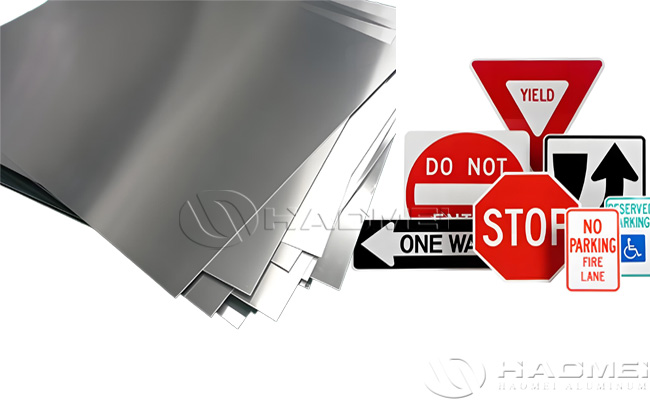-
- News Center
- Related News
-
- Aluminum Sheet 1060 For Traffic Signages
- 2015 Haomei Annual Meeting of the New Year

- Aluminum sheet for tr
-
- Home > News > Industry news >
- Aluminum Sheet 1060 For Traffic Signages
Aluminum sheet for traffic signages are usually made of aluminum alloy materials, and their characteristics must meet the requirements of weather resistance, mechanical strength and processing adaptability. Common alloys used of aluminium sheet for traffic signs include 3004 (excellent corrosion resistance and formability, tensile strength ≥155MPa, elongation after fracture ≥15%), 1060 (pure aluminum, good corrosion resistance but low strength), and 3003 (aluminum-manganese alloy, good rust resistance). Flexible selection in different scenarios: for example, 3004 is suitable for large signs or highly corrosive environments, and 1060 is mostly used for small and medium-sized signs.

Common alloys of aluminum sheet for traffic signages:
- 1000 series (such as 1060 aluminum): pure aluminum, good corrosion resistance, suitable for general road signs.
- 3000 series (such as 3003 aluminum): aluminum-manganese alloy, high strength, excellent corrosion resistance, widely used in highway signs.
- 5000 series (such as 5052 aluminum): aluminum-magnesium alloy, high strength, corrosion resistance, suitable for coastal or highly corrosive environments.
- 6000 series (such as 6061 aluminum): aluminum-magnesium-silicon alloy, with excellent comprehensive performance, suitable for complex structure signs.
Specification of aluminium sheet for traffic signs:
- Common thickness: 0.8mm, 1.0mm, 1.5mm, 2.0mm, 3.0mm, etc. The choice of thickness usually depends on the size of the sign and the required durability.
- Common specifications: 1000×2000mm, 1200×2400mm, 1500×3000mm.
- Dimension deviation: ±5mm (±0.5% when the size is greater than 1.2m), adjacent angle deviation ≤0.5°.
- Surface treatment: In order to increase weather resistance and aesthetics, the surface of the aluminum sheet is usually treated. Common treatment methods include anodizing, powder coating or fluorocarbon spraying. These treatments not only improve the corrosion resistance of the aluminum sheet, but also make it better accept the pasting of reflective film.
The aluminum sheet for traffic signs usually has the following characteristics:
- Corrosion resistance:
Aluminum itself has good corrosion resistance, can remain stable under various climatic conditions, and is not easy to rust.
- Lightweight:
Aluminum is lighter than other metal materials, making it easier to transport and install.
- High strength:
Although aluminum is light, it is still strong enough to withstand external forces such as wind and impact.
- Easy to process:
Aluminum can be processed by cutting, stamping, bending and other processes to make signs of various shapes and sizes.
- Surface treatment:
Aluminum can be anodized, sprayed, coated and other surface treatments to improve its durability and visual effect and ensure the clear visibility of the sign.
- Reflectivity:
Many traffic signs need to have reflective properties to improve visibility at night or in low light conditions. Aluminum can be used in combination with reflective materials.
Aluminum sheet for traffic signages has become the first choice for road sign materials due to its advantages of light weight, high strength, corrosion resistance, low cost, excellent reflective performance, flexible customization and standard compliance. Its long life, low maintenance cost and environmental protection characteristics further improve the cost-effectiveness of the whole life cycle, and it is suitable for diverse scenarios such as highways, urban roads and coastal areas.-
- pre:pre:Thin Aluminum Sheet Introduction
- Next:next:How Much Does Aluminum Sheet Cost?
- Haomei aluminum
- haomei Aluminium Plate




